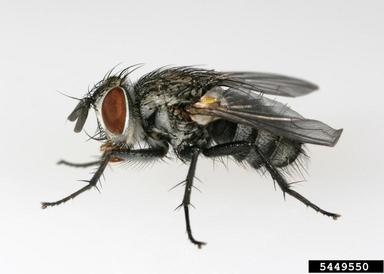Interactions
The luna moth has both positive and negative interactions with other species that occupy the same type of habitat.
One of the negative species
interactions for the luna moth is with
 Compsilura
concinnata, otherwise known as the tachinid fly. In an
experiment authored by Kellogg, Fink, and Brower, the tachinid
parasitoid was found to use the luna moth as a host and is
responsible for a large decrease in the Actias luna
population in New England. The tachinid fly is an "introduced
biocontrol that specifically affects large moths" (Kellogg, et
al., 2003). This parisitism is not all bad though. A 2004 study
by Kumpulainen, Grapputo, and Mappes showed that parasite
interactions with the luna moth encourages sexual reproduction
as opposed to just undergoing the easier asexual form. This
increase in sexual reproduction helps increase genetic variation
and therefore helps with the overall survival and evolution of
the luna moth (Kumpulainen, et al.).
Compsilura
concinnata, otherwise known as the tachinid fly. In an
experiment authored by Kellogg, Fink, and Brower, the tachinid
parasitoid was found to use the luna moth as a host and is
responsible for a large decrease in the Actias luna
population in New England. The tachinid fly is an "introduced
biocontrol that specifically affects large moths" (Kellogg, et
al., 2003). This parisitism is not all bad though. A 2004 study
by Kumpulainen, Grapputo, and Mappes showed that parasite
interactions with the luna moth encourages sexual reproduction
as opposed to just undergoing the easier asexual form. This
increase in sexual reproduction helps increase genetic variation
and therefore helps with the overall survival and evolution of
the luna moth (Kumpulainen, et al.).
Sometimes human interaction with the luna moth can be negative as well. Because not many people get the opportunity to see a luna moth in its natural habitat, they try to increase their odds by aiming for their weakness. Even though adult moths are extremely nocturnal, they are also very attracted to bright UV lights. These lights not only include street lamps, stadium lights, but also flood lights purposely used to attract lunas. This specific human interaction is negative because it can affect luna moth populations due to a decrease in reproduction. Male luna moths are the ones who are flying around at night, and are therefore the ones who approach the bright light instead of following the pheromone released by a female waiting to fertilize her eggs (eol.com).
The luna moth and caterpillar are both prey to larger animals. Vertebrates and invertebrates seem to be dangerous predators that also occupy the same types of habitat as the luna moth. Some of vertebrate predators include nocturnal animals, specifically owls and bats, who are adapt to hunting in the dark night. A common invertebrate predator for the luna moth is the wasp. I guess luna moths are just as afraid of the little black and yellow stripes as humans are!! (http://entnemdept.ufl.edu/creatures/misc/moths/luna_moth.htm)
To link back to the luna moth Homepage, click
here.
To learn more about where the luna moth lives, click
here.
To learn more about what the luna moth eats, click
here.
To view the gallery, click here.